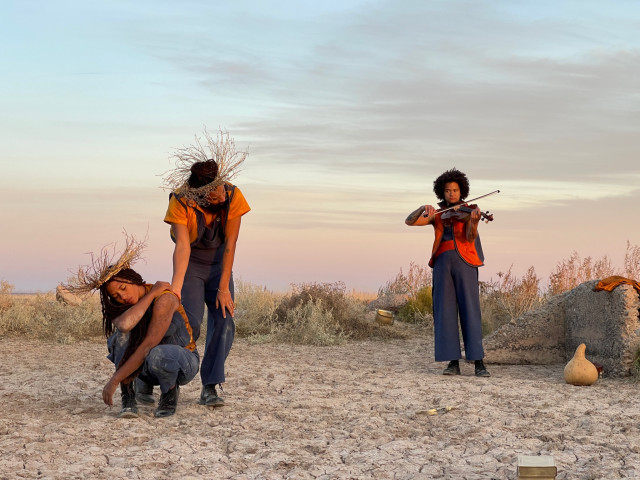
Stages of Tectonic Blackness: Blackdom, Nikesha Breeze, Miles Tokuknow and Lazarus Nance Letcher (Live Performance Nov. 2021) Photo by Noël Hutton.
Stages of Tectonic Blackness: Blackdom by Nikesha Breeze is a National Performance Network (NPN) Creation & Development Fund Project co-commissioned by 516 ARTS, New Mexico State University/University Art Museum, and NPN. The Creation & Development Fund is supported by the Doris Duke Charitable Foundation, the Andrew W. Mellon Foundation, and the National Endowment for the Arts (a federal agency). For more information: npnweb.org
Art Meets History: Many Worlds Are Born
February 19, 2022 – May 14, 2022
In Art Meets History at 516 ARTS, two exhibitions—Many Worlds Are Born and Technologies of the Spirit—looked at how the divergent histories of race, conflict, and colonialism in New Mexico inform how we imagine our futures. Both were curated by Ric Kasini Kadour and Alicia Inez Guzmán, PhD, and were accompanied by a series of public conversations and activities that brought together historic content and contemporary art. Many Worlds Are Born took a cue from the late Chicano writer Rudolfo Anaya, who was best known for his fictional, but still true, portrait of New Mexico, Bless Me, Última, in which he wrote, “Millions of worlds are born, evolve, and pass away into nebulous, unmeasured skies; and there is still eternity. Time always.” Co-curator Alicia Inez Guzman said, “The light, the land, the mysticism, and the people were all his subjects – kinfolk in a constellation that spanned generations. Along the same lines, the sprawling content of this group exhibition also spanned multiple generations and understandings of New Mexico’s many histories, worlds born from beauty, violence, and a deep sense of place.” In partnership with the Art Meets History initiative and Albuquerque Museum Photo Archives, 516 ARTS presented this exhibition that brought the pasts of various cultures in our area into the current moment through a process of historical investigation and contemporary art practices.
The exhibition featured the work of Nikesha Breeze, EveNSteve, Joanna Keane Lopez, Juanita J. Lavadie, Diego Medina, Margarita Paz-Pedro, Jeanna Penn, Marlena Robbins and Leo Vicenti.
Co-curator Ric Kasini Kadour wrote, “A premise of this project is that history is not a single, linear narrative but many threads woven together. Ruptures in the fabric of society can be traced to broken historical threads. While we may know our own history, we may not know the histories of others. Erasure, denial, forced amnesia and an unwillingness to confront inconvenient and uncomfortable histories allow systems of oppression to persist. The antidote, we believe, is to learn as much as we can about the histories of others. Through this process, we can repair the social fabric and build a society that is just and fair for all people.”
Guzmán wrote, “These exhibitions challenge the persistence of both exotic and reductive visions, indeed the very notion that there exists a singular history of New Mexico. The artists draw from their own experiences and relationships to places across this region’s vast and mutable landscape offering insight into their homes, their ancestors’ homes, or the homes of their kin. They show not only the presence of conflict, assimilation, and contamination over the centuries, but also resilience, dissent, and the power of memory to transform the present and future. Altogether they forge an archive of embodied views — New Mexico’s many worlds.”
To develop the projects on view, many of the artists engaged with the Albuquerque Museum’s Photography Archives, and took part in Artist Lab: Art Meets History in New Mexico, an educational program in which participating artists were asked to examine personal and collective histories in New Mexico and the Southwest. In addition to the artists’ projects and installations across many mediums and contemporary art practices, a selection of the historic reference photographs from the Albuquerque Museum Photography Archives will be on view.
This exhibition was the first in the series of two that examines New Mexico history using images from the Albuquerque Museum Photo Archives. The second, Technologies of the Spirit opened June 11, 2022.
PRESS
“Exhibit challenges the traditional idea of a singular New Mexico story,” by Kathaleen Roberts for the Albuquerque Journal
“Artists Explore Divergent Histories in Many Worlds Are Born,” by Maggie Grimason for Hyperallergic
“Art Meets History: Many Worlds Are Born and Technologies of the Spirit,” Green Fire Times, May/June 2022
““Each shirt represents a dream”: The fibers of New Mexico history,” by Sol Traverso for Taos News
“Art Meets History” by Devin D. O’Leary, The Paper